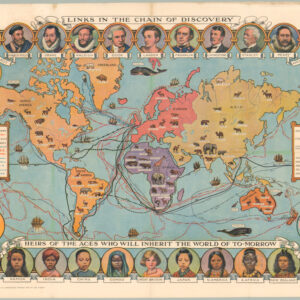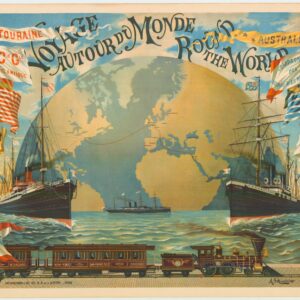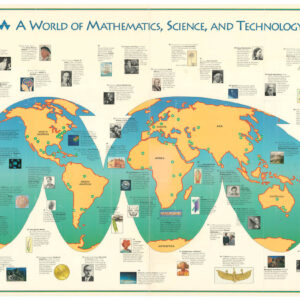Spectacular old color Ortelius world map showing the world as known in 1587.
Typus Orbis Terrarum
Out of stock
Description
One of the most famous world maps ever made, “Typus Orbis Terrarum” featured in the world’s first atlas, Theatrum Orbis Terrarum.
The map includes a massive Terra Australis Nondum Cognita, a distinctive Northwest Passage below the Terra Septemtrionalis [sic.] Incognita, and other early cartographic hypotheses. The early mis-projection of Japan is prominent, as is the equally conjectural depiction of New Guinea and the Solomon Islands. North America is a study in guesswork and mythical cartography, including a projection of the St. Lawrence reaching to the middle of the continent and a similar river running from the Gulf of Mexico to the same vicinity. Nova Francia is shown, although the map debuted well before the visits of Champlain and the Jesuits.
The map is based most directly upon Mercator’s map of 1569, Gastaldi’s map of 1561, and Diego Gutierrez’ portolan map of the coastlines of the Atlantic.
Cartographic compilation and guesswork
Although the map appears erroneous to modern eyes, it actually contains some of the best compilation work of the period, which was a hallmark of mapmaking in the sixteenth century. Additionally, Ortelius and his colleagues corrected the map as they released new editions of his atlas; for example, the western bulge in South America was removed in the third state of the second edition of the world map.
Many other place names and geographic features remain that were based on dubious sources or hypotheses that have since been corrected. For instance, only the Straits of Magellan separate South America from the large, unknown southern continent. This was common to maps of the period, as a southern continent was thought likely to be hidden in the Pacific and near the South Pole to balance the continents of the northern hemisphere.
Points on that continent derived from sailors’ stories and observations. Take, for example, Psitacorum regio, south of the Cape of Good Hope. Psitacorum regio appeared on Mercator’s 1541 globe and his 1569 world map. It was supposed to have been sighted by Portuguese sailors. Farther west, a pot-bellied depiction of New Guinea is accompanied by a cautionary note, admitting that New Guinea may actually be connected to Terra Australis.
Further east on the southern continent are several place names: Beach, Lucach, and Maletur. They would be familiar to anyone who has read Marco Polo’s Travels. These three places were regions in Java. As can be seen, a Java minori is near to Maletur. This conflation of Java with the southern continent stemmed from an error. Initially, Polo used Arabic usage of Java Major for Java and Java Minor for Sumatra. After a printing mistake made Java Minor seem the largest island in the world in the 1532 editions of Polo’s Travels (Paris and Basel), mapmakers started to make a landmass to accommodate Java Minor, Beach, Lucach, and Maletur.
An intriguing place name lies in the far northwest of North America. Anian derives from Ania, a Chinese province on a large gulf mentioned in Marco Polo’s travels (ch. 5, book 3). The gulf Polo described was actually the Gulf of Tonkin, but the province’s description was transposed from Vietnam to the northwest coast of North America. The first map to do so was Giacomo Gastaldi’s world map of 1562, followed by Zaltieri and Mercator in 1567. The Strait then became shorthand for a passage to China, i.e. a Northwest Passage. It appeared on maps until the mid-eighteenth century.
Quivira, south of Anian, refers to the Seven Cities of Gold sought by the Spanish explorer Francisco Vasquez de Coronado in 1541. In 1539, Coronado wandered over what today is Arizona and New Mexico, eventually heading to what is now Kansas to find the supposedly rich city of Quivira. Although he never found the cities or the gold, the name stuck on maps of southwest North America, wandering from east to west. Here it is used to describe the entire southwest of the North America.
Both places were en route to a clear Northwest Passage that wends its way north of what is now Canada to Europe. Similarly, there is a clear Northeast Passage over Russia. The possibility of a Northwest Passage is an idea that still transfixes geographers today; we are still revising our maps, just like Ortelius did.
Publication data
State number of plate: third plate, first state (cf. Shirley 158, p.181)
Copy from edition: 1608/12 Italian; Page signature: 1
Estimated number of copies printed: 3850
Estimated number of loose copies in circulation: 161
Area displayed: the world as known in 1587
Background: How to understand color on antique maps
The terms ‘Original’ or ‘Contemporary’ or ‘Old’ color are used for the most part interchangeably in the antiquarian map world to refer to color that was applied to a map immediately after or close to the time of its printing as part of the publication and selling process. Until the development of color printing (halftone, chromolithography, etc.), maps were colored by hand: sometimes by the publisher or people hired by the publisher, sometimes by independent colorists working for the map’s owner.
‘Modern color’ is used to describe color that was added long after initial production, even if the color is centuries old. Both in cases where original coloring faded or burned, and when maps were issued without color, it is not unusual to find 17th century maps colored (or re-colored) in the 18th and 19th centuries. This color is grouped with the work of present-day colorists under the term ‘modern,’ and when skillfully applied both can be quite visually pleasing.
Historical background
For most of the history of mapmaking, color was uncommon but not unknown.The oldest known maps were incised into clay tablets in ancient Babylon and could obviously not be colored. But as the medium evolved, we see that for some of the earliest preserved maps, coloring played an important role in encoding or embedding concepts in schematic visual renditions of the world. Impressive charts like the Tabula Peutingeriana, early Arab or Ptolemaic maps, the 6th century mosaic map in Madaba, Jordan, and Medieval portolan charts all used color to distinguish individual features and enhance the visual impact.
From the late 15th to the late 16th century, a period that saw the invention of the printed map and the rise of map publishing as a business, color remained uncommon. Maps would often figure within the context of geographic books or itineraries and would rarely be subjected to coloring. However, some map publishers did begin to color maps in order to make them more sellable by enhancing appearance and readability, as well as to highlight specific features conveyed in the map’s composition.
Coloring would be applied to maps for decorative purposes, and the more competitive the map business became, the greater the need to enhance them visually. During the 17th century and the Dutch Golden Age of cartography, the hand coloring of maps grew increasingly common and popular, and many mapmakers started issuing formal polychrome sheets to meet the growing demand. A pioneer in this regard – in part due to his technical skill and strong sense of aesthetic – was Willem Janszoon Blaeu, who began issuing magnificent tomes of hand-colored maps.
The depth and splendor of early coloring was in part due to the way pigments were prepared and used. Some of the pigment initially used in the hand-coloring of maps became unavailable during the 18th century, making the original techniques a lost art. Coloring was used in different ways and for different purposes. Four main colors were usually used to highlight political subdivisions: green, pink, orange, and yellow. A stylized cathedral colored in bright red or gold often marked larger urban centers, whereas blue was commonly reserved for denoting bodies of water. Black was the color most used for toponyms.
Discerning old color
If skillfully applied with historical correctness, modern coloring can sometimes be very difficult to distinguish from contemporary or original color. Discerning between the two takes experience.
When evaluating maps for original color, there are a number of features that one might look for in order to confirm that the coloring is indeed original. The most common and simple technique is to examine the verso of the map, as old greens and browns in particular often show through the paper as a result of oxidation.
Another common, albeit more difficult, way of discerning original color from later coloring is holding it up to historical and stylistic scrutiny. Often, the original coloring of landmasses constituted a reflection of political subdivisions at the time of publication. Such realities would sometimes either be forgotten or disregarded when maps were subjected to later coloring. The reason for discrepancies of this sort was usually the changing nature of political realities. The later coloring of maps with different political subdivisions could thus be construed as an error in historicity, but is much more likely because the desire for original states is a modern collectors phenomenon. In the 18th and early 19th century, far more importance was lent to maps be usable, and thus the need for updated political divisions was considered paramount.
Cartographer(s):
Abraham Ortelius (1527-1598) was born in Antwerp to Flemish parents in 1527. After studying Greek, Latin, and mathematics, he and his sister set up shop as book dealers and a ‘painter of maps.’ In his heart, Ortelius was, nevertheless, first and foremost a historian. He believed geography was the ‘eye of history,’ which explains why he collected maps and historical documents with such passion. Ortelius traveled widely in pursuit of his interests, building contacts with mapmakers and literati all over the European continent.
Ortelius reached a turning point in his career in 1564 with the publication of a World Map in eight sheets, of which only a single copy survives. In 1570, he published a comprehensive collection of maps titled Theatrum orbis terrarum (Theatre of the World). The Theatrum is conventionally considered the first modern-style atlas. It was compiled by collecting maps and charts from colleagues across the continent, which Ortelius then had engraved in a uniform size and style. The engraver for most of the maps in Theatrum was none other than the famous Frans Hogenberg, who also served as the main engraver for the 16th-century urban atlas Civitates Orbis Terrarum, published with Georg Braun in 1572.
Hogenberg’s re-drawn and standardized maps formed the basis of the first atlas in history (even though it was Mercator who was the first to use the term a few decades later). Unlike many of his contemporaries, Ortelius noted his sources openly and in the first edition, acknowledged no less than eighty-seven different European cartographers. This ‘catalogus auctorum tabularum geographicum‘ is one of the major innovations of his atlas. The list of contributing mapmakers was kept up-to-date for decades after Ortelius’ death. In the first edition of 1570, this list included 87 names, whereas the posthumous edition of 1603 contained no less than 183 names.
While compiled by Abraham Ortelius in the manner described above, the Theatrum was first printed by Gielis Coppens van Diest, an Antwerp printer experienced with cosmographical books. Van Diest was succeeded by his son Anthonis in 1573, who in turn was followed by Gillis van den Rade, who printed the 1575 edition of Ortelius’ atlas. From 1579, Christoffel Plantin took over, and his successors continued to print Theatrum until Ortelius’ heirs sold the copperplates and the publication rights to Jan Baptist Vrients in 1601. In 1612, shortly after Vrients’s death, the copperplates passed to the Moretus brothers.
Condition Description
Excellent, heavy paper; a tear at the bottom right corner has been repaired.
References


![[Dr. Seuss] This Is Ann….. She Drinks Blood!](https://neatlinemaps.com/wp-content/uploads/2024/05/NL-01354_thumbnail-300x300.jpg)


